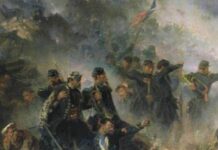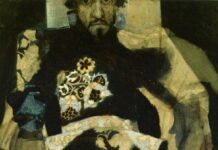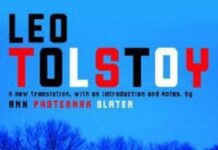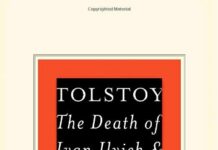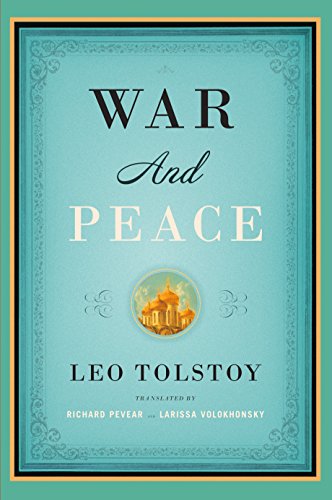
Ebook Info
- Published: 2008
- Number of pages: 1296 pages
- Format: Epub
- File Size: 1.31 MB
- Authors: Leo Tolstoy
Description
From the award-winning translators of Anna Karenina and The Brothers Karamazov comes this magnificent new translation of Tolstoy’s masterwork.
War and Peace broadly focuses on Napoleon’s invasion of Russia in 1812 and follows three of the most well-known characters in literature: Pierre Bezukhov, the illegitimate son of a count who is fighting for his inheritance and yearning for spiritual fulfillment; Prince Andrei Bolkonsky, who leaves his family behind to fight in the war against Napoleon; and Natasha Rostov, the beautiful young daughter of a nobleman who intrigues both men.
A s Napoleon’s army invades, Tolstoy brilliantly follows characters from diverse backgrounds—peasants and nobility, civilians and soldiers—as they struggle with the problems unique to their era, their history, and their culture. And as the novel progresses, these characters transcend their specificity, becoming some of the most moving—and human—figures in world literature.
User’s Reviews
Review “Shimmering. . . . [It] offers an opportunity to see this great classic afresh, to approach it not as a monument but rather as a deeply touching story about our contradictory human hearts.” —Michael Dirda, The Washington Post Book World“A major new translation . . . [which] brings us the palpability [of Tolstoy’s characters] as perhaps never before. . . . Pevear and Volokhonsky’s new translation gives us new access to the spirit and order of the book.” —James Wood, The New Yorker“Excellent. . . . An extraordinary achievement. . . . Wonderfully fresh and readable. . . . The English-speaking world is indebted to these two magnificent translators for revealing more of its hidden riches than any who have tried to translated the book before.” —Orlando Figes, The New York Review of Books”Tolstoy’s War and Peace has often been put in a league with Homer’s epic poems; it seems to me that the same might be said for Pevear and Volokhonsky’s translation of his great novel. . . . Their efforts convey a much closer equivalent in English to the experience of reading the original.”—Michael Katz, New England ReviewFull review here: http://www.nereview.com/29-4/29-4Katz.htm
Reviews from Amazon users, collected at the time the book is getting published on UniedVRG. It can be related to shiping or paper quality instead of the book content:
⭐ It is unlikely that anyone who has the endurance to finish this book would give it a poor review. That would still be true, however, if it were one-third the length. It is, if not the best novel ever written, certainly on a very short list of great works of literature.The beauty of the prose, for me, is the fact that Tolstoy speaks through subtlety. His powers of description are beyond comparison, and in fact there is relatively little dialogue given the length of the book. But the focus of his descriptive powers is not the scenery or the landscape, as is often the case, but the gesture, the look on the face, the social context of the event. This is a subtlety that is lost in our dialogue-heavy, action-packed world today, and is almost foreign to most contemporary authors.Which, in part, also explains why War and Peace seems inapproachable to many contemporary readers. Many of us have lost touch with subtlety and if you are one of those, reading this book would be the greatest gift you can give yourself in the months ahead.“Helene was so good-looking that there was not only not a trace of coquetry to be seen in her, but, on the contrary, it was as if she was embarrassed by her unquestionable and all too strongly and triumphantly effective beauty. It was as if she wished but was unable to diminish the effect of her beauty.” When was the last time you read such a descriptive passage that used so few descriptive adjectives?One of the common criticisms of the book is that the characters often speak in French, which is retained in this translation. This is more true in the beginning, however, and, in total, the French represents a small portion of the total prose. And translation is provided, although the electronic version requires a certain amount of digital (as in fingers) dexterity that I don’t seem to have.Tolstoy, however, is sensitive to the inconvenience and I can’t recall a single passage in which the French was central to either the theme or the storyline. It is mostly there for context, so even if you pass over the short phrases you will miss little other than the full experience that Tolstoy intended. Also remember that French and English are not all that foreign to each other and the most important words in French can be easily guessed by English readers with a little lingual abandonment.Similarly, the complexity of Russian naming conventions need not be the burden it often is to the English reader. Tolstoy most definitely wrote a novel, not a mystery thriller, although he claims that it is not a novel. The storyline is not the book; it serves the theme. That, along with the rich context provided by Tolstoy’s prose, means that you don’t have to recognize each name before you complete the sentence. Nine times out of ten the identity will become obvious before the scene ends. And for that exception there is a handy reference guide. My advice: when you encounter a name that you don’t immediately recognize, read on for a bit before you look it up.As a thematic novel, it is not Tolstoy’s intent to document the Napoleonic wars, although that is the rough timeline of the book. He uses the history more to reveal the cultural themes he seeks to reveal—the culture of the Russian aristocracy at the time.While that culture contrasts sharply with the way in which most Americans are inclined to think of Russia, the themes are quite timeless. There are many passages which could as easily be describing today’s aristocracy—the wealthy elite. As Yogi Berra reminded us, “The more things change, the more they stay the same.”Tolstoy is particularly philosophical about war. When I asked a friend of mine who was a Marine veteran who served in the jungles of Vietnam what he thought about the movie, “Saving Private Ryan”, he noted that no one has ever been able to capture the sheer chaos of war on film. Tolstoy, however, does capture it in prose and it is moving without being graphic or overly detailed. You nonetheless feel that you are immersed in the same situational context as the young infantryman thrown about in the chaos of futility and death.In the end, this book easily earns its reputation as one of the best novels ever written. Through his grasp of subtlety and his incomparable ability to build intangible impressions with tangible prose, Tolstoy takes us through the full range of human emotions, accomplishment, and vacuity.Unlike most contemporary authors, Tolstoy actually “tells” us little. As many great novels do, he merely puts themes out there for us to consider and mold to our own experience and our own lives. You will be surprised at how much of yourself you find in early 19th Century Russian characters and events. If not timeless, the insight and the human revelation are universal. As Tolstoy himself wrote, “We can know only that we know nothing. And that is the highest degree of human wisdom.”Indeed!
⭐ This is a knock off translation with no information concerning the translator; the book also lacks the original Introduction, list of Principal Characters, and other items. A side-by-side comparison of this translation with that of Pevear/Volokhonsky indicates that this version is definitely NOT the translation as advertised. To be sure you are receiving the Pevear/Volokhonsky translation, order the paperback edition (though reviewers note that the typeface is incredibly small) or search online for a used copy of the original hardback edition (Alfred A. Knopf, 2007)/ISBN-13: 978-0-307-26693-4.
⭐ I have, at various times, tried to read four different editions of War & Peace (Penguin, Signet, Barnes & Noble, and now this) and by far, this (the Pevear and Volokhonsky translation from Vintage Classics) is the best edition I’ve seen. This edition is everything I was looking for in a copy of War & Peace and I cannot recommend it highly enough.Pros:It is highly readable. Translating texts is always difficult, because you want to retain the feel of reading a Nineteenth century work but use language that makes the work accessible. Personally, I found some editions (Barnes & Noble, Penguin) to be hard to read and comprehend, especially when you first begin. This edition is a relative breeze to read.It has French translations. When reading the Signet edition, I found myself using google translate to understand sentences or phrases left in the book in French. Other editions translated most of the French but left phrases here and there untranslated and in the text, without footnotes. I understand in the original, Tolstoy wrote entire passages in French but provided translations in the foot notes. This edition follows that pattern. There are entire passages in French, but they are translated in the footnotes on the page.It has historical end-notes and an index. I am not unfamiliar with European and Russian history, but I, like most people, have no more knowledge than what I learned in my freshman world history class. This work has end notes in the text to provide context. Though it slows me down, I find myself flipping to the back of the book and reading every end note when the text provides it. I cannot stress enough how helpful this has been. The index is likewise helpful. It is an alphabetical list and short biography of the historical characters and places mentioned in War and Peace.It includes a short chapter summary. At the very end of the book, there is a chapter summary for a collection of chapters sharing a theme or describing the same event. The summary is no more than a sentence long and provides a nice refresher when you are trying to recall what happened when.Cons:Compared to editions that translate all the French, reading in the footnotes can be burdensome. I personally don’t mind, but I can see how that might trip some people up.If you are looking for a copy of War and Peace, this is the one to get. Trust me.
⭐ I bought the Kindle edition, but this applies to all editions shown on this page. There is a copyright notice, but absolutely no mention of who did the translation. I bought the Kindle edition thinking the information would show up, but it did not. I want the Pevear translation, complete with notes. This edition has some notes at the end, but no endnotes or footnotes, or any of the other notes that are supposedly in the Pevear translation. And I need the Pevear translation on Kindle, because I can’t read the tiny print of the hardcover or paperback editions. Come on, Amazon! Police your listings!
⭐ This translation of War and Peace is so bad you will do a lot better to spend some money and buy a different version. I have found it so unreadable that I bought another version in French, which is just fantastic. On almost any given page there are words I don’t understand, which when I look them up are always listed as “archaic.” The translator (I can’t see who it is or when it was translated in this Kindle version) consistently uses turns of phrases like “thought he” or “said he” and the extremely strange “thou” and “thy” to show that Tolstoy used the INformal form of address! Here’s an example, “”Who are thou? Thou dreamest that thou art wise because thou couldst utter those blasphemous words,” The book is full of expressions that the modern reader will find incomprehensible, such as, “invited him to draw his covert, ” “if you scare away the beast, Daniel’ll give it you!” Do yourself a favor and buy a modern translation to enjoy this magnificent book.
⭐ I wanted the Richard Pevere edition and thought I was getting the hard cover of the same edition. It’s a fake. Printed in China without any info on who the translators are. I’m very very disappointed. Wish I could give it 0 star.
⭐ “Look Inside” shows pages from Richard Pevear and Larissa Volokhonsky’s translation of War and Peace. So one assumes that it is that particular translation, even though no translator is indicated in the book information section below. However, when this edition arrived, the translation was by Constance Garnett (uncredited in this edition but verified through a simple Google search on some sample text), NOT Pevear and Volokhonsky!! Another caveat is that the font size is very small and hard to read, probably to reduce the number of pages and save on printing cost. Amazon should remove “Look Inside” for this edition, as it shows a totally different translation.
⭐ This review is a mere impression of the reading experience of War and Peace and not a long analysis.Having a meager amount of knowledge about this period of time I probably missed a lot of historical subtext, but a novel for popular consumption should not require a preexisting degree in Russian history to enjoy it. The author should paint a vivid portrait of the period he/she is presenting.To say I was disappointed is an understatement. Having just finished it I am hard pressed to recall anything about the novel. I was expecting a story on an epic scale with unforgettable characters and scenes which would take my breath away. If left me wholly indifferent. The final section was a struggle to get through as it rambles endlessly about humanity and free will. Perhaps had these themes been more prominent in the story it might have made it a more memorable and compelling read. I imagine literary scholars will cringe at these comments and say how dare I second guess a genius like Tolstoy.I am glad that it is behind me and I can say that I have read War and Peace but I find it highly unlikely that I would ever reread it.
⭐ I expected reading this book to be a chore. It was not. Tolstoy, not surprisingly, is an engaging author. It does take a while to get into the book and it is hardly a “page turner”. But Tolstoy can be quite humorous in his asides, and sometimes rather snarky. Obviously a great deal of military research went into this book, for he gives details of battle events; disobeyed orders and discipline problems. I needed to be able to flip back to the list of characters, in order to keep the three names of each Russian character straight. There are pages of historical notes, which are helpful to explain historic references, social norms, etc. I don’t speak Russian, so I can’t speak to the accuracy of the translation, but these authors produced a very readable, not-quite lyrical translation. It was a lengthy, but enjoyable read and I’m glad I tackled it.
⭐ Tolstoy is the best. That is all you need to know.This review will be more about the Kindle edition. A lot of War and Peace is in French, as the Russian aristocrats (and the French characters) often speak French. I can read some of this, but not all of it; the translations of the French passages are supposed to be accessible via footnotes. But sometimes the Kindle Paperwhite does not do a great job of letting you access the footnotes: you tap the footnote and nothing happens, or it just goes to the next page instead of to the footnote. Sometimes it works, but usually it doesn’t.For that reason, if you can’t read French, I would recommend NOT buying the Kindle version, but getting a hard copy instead, because it will be easier to read the translations of the French passages.
Keywords
Free Download War and Peace (Vintage Classics) in Epub format
War and Peace (Vintage Classics) Epub Free Download
Download War and Peace (Vintage Classics) 2008 Epub Free
War and Peace (Vintage Classics) 2008 Epub Free Download
Download War and Peace (Vintage Classics) Epub
Free Download Ebook War and Peace (Vintage Classics)

